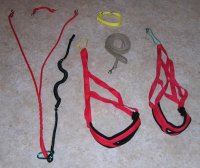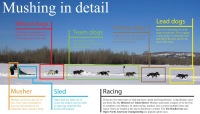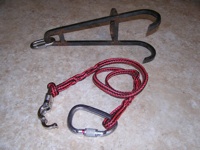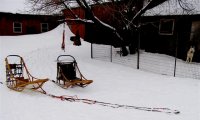Mushing
Mushing is a general term for a sport or transport method powered by dogs, and includes carting, pulka, scootering, sled dog racing, skijoring, freighting, and weight pulling. More specifically, it implies the use of one or more dogs to pull a sled on snow.
- from the Wikipedia article on Mushing.
Immediately after my first time on the back of a dog sled I knew that I would be mushing for the rest of my life. I was completely drained after only a short 4km run, (it's not as easy as it looks folks) but I couldn't wait to do it again. And again, and again...
The thrill of gliding over a snow covered trail with the whoosh of the sled
runners, and the soft panting of dogs as they do the work they were bred for with such joy and enthusiasm. The
moments when you aren't pedaling enough going up hills and the wheel dogs turn their heads to look back at you as if to say
"come on man, give us a hand!". Dogs so eager to run that they jump into their harness. The times when you
stop on the trail for just a bit too long and the dogs start to whine and jump, "Hey you, we want to go now!"
Each time you hit the trails you learn something new about yourself and your dogs.
These are the reasons I enjoy working with my dogs.
Want to Play?
My advice to rookies: Read everything on the subject that you can get your hands on; learn from other people's experiences. Join a local club if there is one near you. Most groups will be ready to welcome you if you come ready to work and have an open mind. Learn all you can from knowledgeable people. Always be watching and listening. Ask questions, the only stupid ones are the ones you don't ask. Start slow and enjoy the ride. Never, ever let go of the sled; everyone falls off the sled at least once. Get up and run!
The number one rule is: the dogs always come first, ALWAYS! When you are done with your run, take care of the dogs; water, first-aid, etc. The dogs will give you 100% if you treat them well. It goes without saying that you always clean up after yourself and your dogs.
Gear
No matter which mushing sport interests you, having good gear is important. Good equipment ensures that both you and your dogs will be safe while working. While you can buy most equipment ready-made and you probably should when starting out, mushing is still for the most part a do it yourself sport. Below is an explanation of some of the necessary equipment when mushing dogs. Beginners can often borrow equipment on their first few outings, you don't need to have the whole kit to get started.
Sleds, Skis and Wheels
If you can't find one second hand. a basic 4-6 dog sled is going to start at about $500. Brakes and other equipment aren't included so plan to spend a couple hundred more. Another option for one or two dogs are cross country skis, which come with all the associated costs (boots, binding, poles). For the off-winter months a 2 wheeled kick scooter or trike will do the job. if you already have a bicycle handy there is also the option of bikejor.
If you don't have room for all sorts of dog related gear in a small apartment, you may find cani-cross interesting. All you need is a harness for yourself and your dog, a good pair of running shoes and a place to run.
Once you've got something under your feet, you can move on to the gear.
Collars and Leashes

A 'Y' leader section with short neckline above, bungee line, harnesses, sledding collar and long leash
When buying a collar for sport, avoid anything with plastic snaps or buckles. I would recommend a one-piece design with a solid O-ring. Always carry a good leash.
Harnesses
There are many types of harness, but most popular is the simple "X" across the back design. The most important thing is to make sure that you've measured your dog properly before you order. A harness that fits properly will be more comfortable for your dog and reduce the likely-hood of injury.
Lines
The gang-line is the central line from the sled to which each dog is attached, usually in pairs. They come in two styles, polyethylene rope and plastic coated cable. I prefer using polyethylene rope because it can be easily repaired if it's been chewed though. Rope tangles easier than cable, which remains fairly rigid, but good luck fixing it when it breaks out on the trail.
Carabiners and Snaps
These are more important than you might believe. They keep the dogs attached to you or to the sled. Do not buy snaps from a hardware store. They aren't meant to take the abuse that they would see in a lifetime of use on the sled. The same goes for carabiners. The locking type are recommended. Always double check the locks before you take off.
Brakes & Snow-hook
Most sleds come equipped with a basic aluminum bar brake bolted to the sled. It has two sharp teeth that you push down into the snow with your foot to slow or stop. The snow-hook which is attached to the sled using a nylon rope is your anchor. It is the only way you will be able to secure the team if you need to get off the sled. There are many designs but the basic idea is the same, two sharp hooks that bite into the snow or hold onto a tree. Always take care however, as an airborne snow hook can easily end up in your leg.
Human Gear
The more comfortable you are while working with your dogs, the more enjoyable the experience will be. Make sure you have good winter gear and are dressed in layers. If you start to sweat, which can happen even at -20°C, you can remove a layer. On the other hand you may have to spend longer than you expect outside if you are searching for a siberian who has chewed through their harness and ran off to explore the trail ahead without you. Be prepared.
The Repair Kit
There will come a time when you need to repair a chewed harness or gang-line. All it takes is one or two good bites, just a few seconds when your attention is elsewhere. Keep some spare nylon webbing and strong thread handy for patching harnesses. It's always good to have some extra rope handy too. Enthusiastic Siberians will jump up on you, be prepared to make repairs on your winter coat or snow pants. Learn to sew and to tie a square knot, or make friends with someone who can.
GPS
While not a necessity, having a GPS when you are out with your dogs can be really interesting. I use Mushometer, an App that I created specifically for tracking my runs and the performance of my team.
The App tracks all kinds of useful statistics and the resulting GPX files can be imported into Google Earth.

On the links page you can find more mushing resources and equipment suppliers that I use.
Have fun with your dogs!




